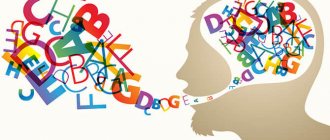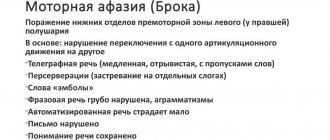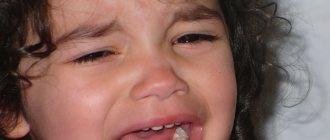In children, speech skills develop gradually until approximately 4 years of age. Some errors in speech are present in children of older preschool age. Over time, with proper communication between the people around them, mistakes in conversation and perception of texts in children disappear.
If a mature person does not understand the written text, can name only a few main words from the information read, does not express his thoughts well, and his speech lacks verbs, prepositions, and conjunctions, he should consult a doctor.
Perhaps the combination of these signs is an expression of a disease called agrammatism. There are several types of deviation. Correct diagnosis can only be made by a qualified doctor after a comprehensive examination.
What underlies the development of the disorder?
A person’s ability to comprehend and reproduce speech depends on a large number of factors:
- age;
- level of general development;
- education;
- communication environment;
- communication skills;
- psychological status;
- physical condition.
The onset of the disease can be triggered by anatomical features, organic changes in local areas of the brain, for example, the Sylvian fissure, the frontal or temporal cortex of the dominant hemisphere.
Normal pronunciation of words and syntactic structures is possible with the impeccable functioning of all nerve cells in the brain.
Total agrammatism in children can also cause impaired hearing during the development of speech. If sound waves are poorly perceived by auditory analyzers, the child hears poorly, and it is difficult, even impossible, for him to formulate sentences correctly.
Speech skills can only be developed through repeated full listening to verbal expressions and immersion in the audio environment of the language.
Emerging speech disorders in adults who already have developed sentence pronunciation skills cannot be explained by changes in the functioning of auditory analyzers. In such situations, there is a high probability of neurological disorders.
Agrammatism is characteristic of the conditions of alalia, aphasia, speech of people without hearing or with poor hearing, and children with developmental delays.
Diagnostics
Identification of agrammatisms in writing and in oral expression is carried out by a speech therapist-defectologist during a pedagogical examination. To assess the condition of the HMF, a consultation with a neuropsychologist is required. The general diagnostic plan consists of the following stages:
- Diagnostics of oral speech.
Primary attention is paid to examination of vocabulary and grammar. Vocabulary, skills of forming words using prefixes and suffixes, changing words by numbers, gender, and cases are explored. Tasks are given to retell the text, compose a story based on a plot picture and a series of pictures. A comprehensive examination allows us to identify morphological agrammatisms. - Diagnostics of written speech.
Students are taught written work. Students are asked to make sentences using pictures and supporting words, and write a summary. When performing written tasks, as a rule, syntactic and semantic agrammatisms are detected. - Examination for aphasia.
In patients with aphasic disorders, the understanding of speech (questions, instructions) and the ability to speak (automated, repeated, spontaneous speech, naming objects, composing stories) are examined. The ability to write and read is analyzed. The examination may reveal expressive or impressive agrammatism. - Neuropsychological diagnostics.
Within the framework of the neuropsychological approach, an individual’s ability to program, regulate and control a speech act, as well as the peculiarities of processing auditory-verbal and visual-spatial information, are assessed. In the presence of agrammatisms, neurodynamic disorders involved in the organization of speech activity are identified.
Correction of agrammatism
Manifestations of agrammatism
Examples of agrammatisms
It is easier for a person with this disease to understand unambiguous sentences. For example, the phrase “I bought bread” will be understood more easily than the sentence “I am listening to you.” In the second case, unlike the first, the reverse action option “Are you listening to me” is possible.
Short phrases with the classic word order “It’s raining outside” are easier to understand, as opposed to a larger sentence with clarifications “It’s raining incessantly outside again.”
A sick person does not communicate quite competently from a literary point of view. Everyday speech structures differ significantly from correctly constructed sentences. The ability to perceive ordinary speech in people with agrammatism is significantly reduced.
Symptoms can be identified by a specialist through attentive communication, demonstration of visual materials, accompanied by a request to describe them, talk about them. If a person is sick, his speech consists of the simplest sentences, with a minimum of words, often pronounced slowly.
Forms of violation
Experts distinguish two main forms of agrammatism:
- Impressive is characterized by a lack of understanding of speech in whole or in part. The root adjective in the title means “perception” in English. Changes in the functioning of brain cells do not allow the sound signal to transform into thoughts and images.
- Expressive disorders are identified when it is impossible to use prepositions, declensions, and cases in speech; when spoken sentences are formed incorrectly or incompletely. The root of the adjective in this title means "expression" in English. Problems with the functioning of the local area of the brain prevent the transformation of thoughts into speech phrases. Depending on the location of the problem area, the resulting speech anomaly (aphasia) may be sensory or motor in nature.
Sensory changes are caused by a violation of the ability to feel and perceive a sound signal.
Motor disorders in Broca's center cause difficulties in controlling the muscles of the larynx, tongue, and jaws, which do not allow speech to be reproduced well. Often the patient can only pronounce basic words.
His speech resembles the text of a telegraph message, in which nouns predominate or, conversely, only verbs are present. Such specific features make it possible to clarify the localization of the brain area with impaired activity.
Dyslexia
Dyslexia is a reading disorder that occurs as a result of underdevelopment or dysfunction of certain areas of the cerebral cortex. In parallel with dyslexia, a child may develop dysgraphia. Dysgraphia is a writing disorder. Dyslexia is rare, but despite this, it can make it difficult for a child to learn. Reading is at the core of the world's education system, so learning problems can have long-lasting consequences. This disease occurs mainly in boys.
Dyslexia in children in most cases appears at the age of 7 years, so problems with reading are most often observed in younger schoolchildren. Various reading disabilities become more obvious by second grade. In some cases, dyslexia is compensated over time, but sometimes it persists in older children. But with early detection and timely, comprehensive treatment, the course of dyslexia can be changed for the better. Treatment should be long-term, intensive and systematic. Sometimes a child may be genetically predisposed to this disease, in which case dyslexia is observed in several family members at once. Children with this disorder make many mistakes when reading. They read slowly, and they may pronounce words incorrectly, skip some sounds, add unnecessary ones, and rearrange letters. Children find it difficult to perceive certain sounds by ear, which leads to the fact that they do not use them in their own oral and written speech, when reading. It is very difficult for a child with dyslexia to distinguish sounds that are similar in acoustic characteristics: B-P, D-T, K-G, S-Z, Zh-Sh. That is why children with such problems have no interest in reading, retelling, or presenting various types of texts. Whenever possible, these forms of work are not given to them.
Let's look at the mechanism of development of dyslexia, this will help to better understand the essence of this disease. A person has three types of hearing: physical (the rustling of leaves, the barking of a dog, the sound of rain), musical (the pleasure of a favorite song, the immortal music of great composers), speech (understanding speech, the difference between sounds). When speech hearing is not sufficiently developed, a person is unable to distinguish similar consonances and does not correctly perceive speech addressed to him. When speech hearing is impaired, difficulties arise in reading and writing. This is a natural process, because a child who cannot clearly hear the speech of other people cannot read correctly. In a child with dyslexia, the relationship between sounds and letters is disturbed. Having heard a sound, he is not able to quickly imagine it in the form of a sign. But the flow of speech that he perceives is very fast. That is why mastering literacy is difficult for such children.
But it is necessary to teach a child, since a change in one or more sounds entails a change in the meaning of the word: stick-beam, daughter-dot. The child just replaces a dull sound with a voiced one, a hard sound with a soft one, but the word completely changes its meaning. To correct dyslexia in a child, parents must not only work with him on their own, but also be sure to involve a specialist. All classes aimed at correcting a child’s reading must be built in a certain system. During the lessons, the child must master the pronunciation of individual sounds and learn to relate the sound to the letter. For better results, the speech therapist uses various visual materials. You need to understand that dyslexia is a condition that requires the cooperation of parents and a speech therapist to identify and correct it; only in this case can lasting positive results be achieved.
Establishing diagnosis
Correct diagnosis is the result of comprehensive observation and examination. It is very important to determine:
- general condition of a person,
- his psychological and neurological status.
During communication, the specialist evaluates:
- rate of speech;
- variety of syntactic forms used;
- correct use of cases and declensions in speech;
- the presence of unions;
- the presence of prepositions in dialogue and monologue when describing a visual object.
When testing, the number of words and syllables in spoken sentences and the consistency of the endings used are assessed.
To identify disorders of brain activity, it is recommended to do an encephalogram, ultrasound or tomography.
Summarizing and analyzing the information received, the specialist makes a decision to establish a diagnosis.
Treatment methods
Agrammatism is a neurological disorder that requires the help of qualified specialized doctors. Medical treatment, depending on the age and severity of the patient’s condition, may include a course of medication, reflexology, physiotherapeutic procedures, and hypnosis.
Correcting the condition with medications can significantly improve the blood circulation of brain cells and make them function more efficiently.
Impact on active points during reflexology can be carried out using different methods:
- mechanically;
- thermally;
- electrical discharge;
- laser beams;
- electromagnetic waves;
- pharmaceuticals;
- implantation of foreign elements;
- combining techniques.
Author's techniques, tested by many years of experience? differ in the choice of sensitive points on the patient’s body and methods of acting on them.
Positive changes are observed during physiotherapy for expressive agrammatism. For sensory problems, the correct choice of physiotherapeutic methods helps to improve the patient’s perception of sounds.
The influence of motor anomalies is minimized by restoring the activity of the muscles of the larynx, jaw, and tongue.
Agrammatism, like other neuropsychological disorders, can be corrected by professional hypnosis, which improves the quality of spoken speech.
The treatment algorithm is selected by specialists individually. In addition to medical care, the patient will need the help of psychologists, speech therapists, and teachers during the recovery period.
Rules for correcting speech
A qualified speech therapist teacher, having studied the anamnesis and the conclusions of other specialists, selects the optimal course of classes and the linguistic material appropriate to the case. The operating principles are based on:
- personal orientation;
- creating a favorable emotional environment;
- creating positive motivation;
- interaction with parents.
Without the latter, full, effective pronunciation correction is impossible. Parents should follow the recommendations of the speech therapist and do the exercises.
In some cases, the specialist asks the child's guardians to attend the classes so that they can do simple exercises at home. Because two sessions a week with a speech therapist may not be enough.
Creating a favorable environment and motivation are equally important. Problems can be caused by psychological problems, the overcoming of which falls on the shoulders of a speech therapist.
Personal orientation includes:
- recognition of the child's identity;
- creating situations in which the child could realize his own life experience;
- learning based on situations in which the student wants and can learn.
It is impossible to determine the required number of classes at the beginning of work. It all depends on the individual characteristics of the child and the speed of acquisition of skills and abilities.
You can anticipate trouble
To prevent the appearance of agrammatism, the normal neonatal period of the child’s formation is very important.
Neurological disorders of the unborn child can develop during a difficult pregnancy, aggravated by infectious or other diseases. A correct lifestyle and regular observation by an attentive doctor of the expectant mother is the key to the birth of a healthy baby.
Abnormalities in the functioning of brain cells can appear in adults due to past illnesses and circulatory disorders. A preventive measure is a careful attitude to one’s own state of health, the use of general strengthening procedures in everyday practice, and the formation of healthy lifestyle habits.
The condition of patients with agrammatism can be significantly improved, up to complete recovery. Successful treatment is possible with timely consultation with specialists and strict adherence to the doctor’s recommendations.






